Genome-Wide Functional Profiling Identifies Genes and Processes Important for Zinc-Limited Growth of
Zinc is an essential nutrient because it is a required cofactor for many enzymes and transcription factors. To discover genes and processes in yeast that are required for growth when zinc is limiting, we used genome-wide functional profiling. Mixed pools of ∼4,600 deletion mutants were inoculated into zinc-replete and zinc-limiting media. These cells were grown for several generations, and the prevalence of each mutant in the pool was then determined by microarray analysis. As a result, we identified more than 400 different genes required for optimal growth under zinc-limiting conditions. Among these were several targets of the Zap1 zinc-responsive transcription factor. Their importance is consistent with their up-regulation by Zap1 in low zinc. We also identified genes that implicate Zap1-independent processes as important. These include endoplasmic reticulum function, oxidative stress resistance, vesicular trafficking, peroxisome biogenesis, and chromatin modification. Our studies also indicated the critical role of macroautophagy in low zinc growth. Finally, as a result of our analysis, we discovered a previously unknown role for the ICE2 gene in maintaining ER zinc homeostasis. Thus, functional profiling has provided many new insights into genes and processes that are needed for cells to thrive under the stress of zinc deficiency.
Published in the journal:
. PLoS Genet 8(6): e32767. doi:10.1371/journal.pgen.1002699
Category:
Research Article
doi:
https://doi.org/10.1371/journal.pgen.1002699
Summary
Zinc is an essential nutrient because it is a required cofactor for many enzymes and transcription factors. To discover genes and processes in yeast that are required for growth when zinc is limiting, we used genome-wide functional profiling. Mixed pools of ∼4,600 deletion mutants were inoculated into zinc-replete and zinc-limiting media. These cells were grown for several generations, and the prevalence of each mutant in the pool was then determined by microarray analysis. As a result, we identified more than 400 different genes required for optimal growth under zinc-limiting conditions. Among these were several targets of the Zap1 zinc-responsive transcription factor. Their importance is consistent with their up-regulation by Zap1 in low zinc. We also identified genes that implicate Zap1-independent processes as important. These include endoplasmic reticulum function, oxidative stress resistance, vesicular trafficking, peroxisome biogenesis, and chromatin modification. Our studies also indicated the critical role of macroautophagy in low zinc growth. Finally, as a result of our analysis, we discovered a previously unknown role for the ICE2 gene in maintaining ER zinc homeostasis. Thus, functional profiling has provided many new insights into genes and processes that are needed for cells to thrive under the stress of zinc deficiency.
Introduction
Zinc is an essential nutrient for all organisms because it is required as a catalytic and/or structural cofactor for hundreds of proteins [1]. In addition, recent evidence suggests that zinc may serve as an important secondary messenger in various signal transduction pathways [2], [3]. As a cofactor for C2H2 zinc finger proteins and other zinc-binding transcription factors, zinc is also required for transcriptional regulation of many genes [4]. Given these many roles, cells have evolved with efficient mechanisms to maintain intracellular zinc homeostasis and growth when extracellular zinc levels become limiting.
Zinc deficiency is a common problem faced by free-living microbes as well as plants and animals including humans. Among bacterial and fungal pathogens, zinc deficiency is also a key problem they can encounter during pathogenesis. The innate immune system is an important first line of defense against infection. One strategy of innate immunity has been referred to as “nutritional immunity”, i.e. the withholding of essential nutrients such as iron from the invading pathogen [5]. By preventing the pathogen from obtaining essential nutrients, the host limits the growth of microbes and sensitizes them to killing by other agents, e.g. reactive oxygen species. Withholding zinc from microbes is also an important mechanism of nutritional immunity. Up-regulation of the liver Zip14 zinc transporter during infection decreases plasma zinc levels [6]. In addition, neutrophils produce high levels of the S100A8/S100A9 protein dimer called “calprotectin” [7]. Calprotectin is released from neutrophils and binds zinc and other metals to inhibit microbial growth [8]–[12]. Thus, strategies used by cells to grow under zinc-limiting conditions are important for both microbial physiology and human health.
To address the question of what genes and processes are important for growth of a zinc-limited yeast cell, we and others have used genome-wide transcription profiling to identify genes with altered expression in response to changes in zinc status [13]–[16]. In our studies, zinc-deficiency was found to induce expression of over 400 genes [13], [14]. Among these are approximately 80 genes that are direct targets of the Zap1 transcription factor. Zap1 is a zinc-responsive activator protein that increases gene expression in zinc-limited cells [17]. Identification of Zap1-regulated genes has led to a number of insights into how cells adapt to zinc deficiency. Among Zap1 targets is the ZAP1 gene itself. Up-regulation of its own transcription is likely to enhance the overall transcriptional response, especially for genes that have low affinity Zap1 binding sites in their promoters [14]. Zap1 also up-regulates the ZRT1, ZRT2, and FET4 genes that encode zinc transporters needed for zinc uptake [18]–[20]. Zap1 increases ZRT3 expression because this gene encodes a transporter responsible for mobilizing zinc stored in the yeast vacuole [21]. As a final example, Zap1 increases expression of the TSA1 gene. Tsa1, the major peroxiredoxin in the cytosol of cells, degrades hydrogen peroxide [22]. This and other reactive oxygen species increase in zinc-limited cells and Tsa1 is required to combat that oxidative stress. Among Zap1-independent transcriptional effects, we discovered that the unfolded protein response, a response to disruption of processes in the endoplasmic reticulum, is also induced in low zinc and this led to the recognition that ER function requires zinc [23].
As these discoveries demonstrate, transcriptomics analysis of gene expression has told us many things about how cells respond and adapt to zinc-limiting conditions. While useful, however, this approach is limited by the fact that it requires a gene to change in expression in order to be identified as potentially important. Many proteins needed for low zinc growth are likely to be constitutively expressed or regulated at post-transcriptional levels. A complementary approach that does not have this limitation is genome-wide functional profiling [24], [25]. In this approach, a collection of haploid or homozygous diploid deletion strains, each disrupted for function of a different gene, is used to directly assess which genes are important for optimal growth in a particular environment. In addition, mutations that improve growth in that condition can also be identified. We have used this approach to identify genes that are required for zinc-limited growth. Our findings indicate that a large number of different processes are important for optimal growth under these conditions. These include genes that are targets of the Zap1 transcription factor as well as genes involved in endoplasmic reticulum function, oxidative stress resistance, vesicular trafficking, peroxisome biogenesis, and chromatin modification.
Results
A genome-wide screen for mutants altered for low zinc growth
To identify genes important for low zinc growth, cells were grown in either zinc-limiting (LZM+1 µM ZnCl2) or zinc-replete (LZM+100 µM ZnCl2) media. LZM allows for control of the zinc available to cells due to the high concentrations of EDTA (1 mM) and citrate (20 mM) serving as a metal buffers in that medium. Wild-type cells grew markedly better in LZM+100 µM ZnCl2 [area under curve (AUC) value = 34.7] than did cells grown in LZM+1 µM ZnCl2 (AUC = 21.0) (Figure 1A). Thus, cells grown in LZM+1 µM ZnCl2 are zinc limited. Supplementation of 100 µM Zn was chosen as the replete condition because it provides sufficient zinc for maximal growth but does not exceed the metal buffering capacity of the medium and alter the availability of other metals such as Fe and Cu [18]. As an illustration of defective growth in low zinc, we included a tsa1Δ mutant in this experiment. TSA1 encodes the major cytosolic peroxiredoxin in yeast and is required for combating the oxidative stress encountered during low zinc growth [22]. As shown in Figure 1A, the tsa1Δ mutant grew almost as well as the wild-type strain in LZM+100 µM ZnCl2 but very poorly in LZM+1 µM ZnCl2. Our previous studies demonstrated that adding other metals to 100 µM concentrations did not increase growth rate in LZM+1 µM Zn of either wild type or tsa1Δ mutants indicating that these cells are specifically limited for zinc [22].
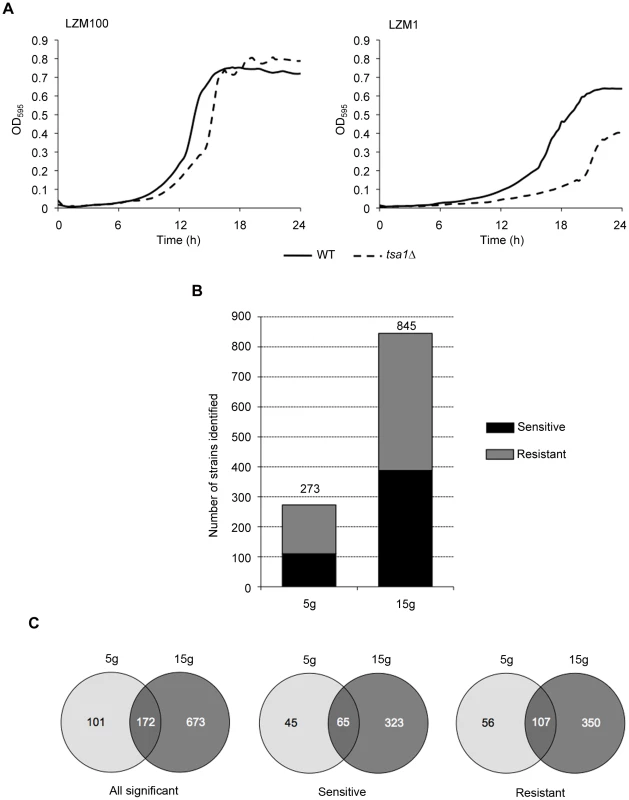
To perform genome-wide functional profiling, mixed populations of 4607 different viable deletion mutants were inoculated into zinc-limiting and zinc-replete media. The cells were grown for either five or fifteen generations, genomic DNA was isolated from the populations, and the unique “barcode” oligonucleotides that identify each mutant in the deletion collection were amplified by PCR. These PCR products were then labeled and hybridized to Affymetrix TAG4 microarrays containing oligonucleotides complementary to the barcode sequences (see Materials and Methods). Four replicate cultures were used for each condition of zinc status and generation number.
Mutations in many genes were found to affect low zinc growth. After five generations, 110 mutants showed a reproducible growth defect in low zinc and were designated “low zinc sensitive”. Another 163 mutants were apparently resistant to low zinc and showed greater prevalence in the low zinc cultures than they did in the zinc-replete medium (Figure 1B). After fifteen generations, a total of 388 mutants were identified as sensitive to low zinc while another 457 mutants showed apparent low zinc resistance. The results for all mutant strains with altered growth are provided in Tables S1 and S2. A list of all strains tested and found to have no significant growth alteration (n = 3663) is provided in Table S3. It is important to note that genes required for growth in low iron (e.g. FET3, FTR1), copper (e.g. CTR1, MAC1) or manganese (e.g. SMF1) did not show a growth defect in low zinc relative to zinc-replete conditions confirming that the growth medium used in these experiments was specifically controlling zinc availability and the availability of other metals was not significantly affected. As shown in Figure 1C, there was a high degree of overlap between the mutants found to have altered growth after five generations versus fifteen generations. We will first consider those mutants showing a growth defect in low zinc. Surprisingly, 45 low zinc sensitive strains were detected after five generations that were not found in the fifteen generation data set. Their absence may be due to false negative effects (e.g. icy2Δ, tsa1Δ) or, alternatively, initially slow growing strains may have accelerated growth in later generations.
Confirmation of the low zinc growth defect by competitive growth assays
To confirm these results for selected mutants, we used an independent and sensitive assay of growth using flow cytometry. The wild-type strain (BY4743) was transformed with an integrating plasmid vector that expressed GFP from a strong promoter [26]. GFP-expressing cells can be readily distinguished from untagged cells by flow cytometry. To compare growth of a GFP-tagged wild-type strain with an untagged mutant, the two strains were mixed together with approximately equal numbers of cells and then inoculated into low zinc or zinc-replete media. After fifteen generations, the level of each strain was assessed by counting ∼20,000 total cells per culture. As shown in Figure 2A and 2B, GFP-tagged and untagged wild-type cells grew equally well in both low zinc and zinc-replete conditions. Quantitation of the results from triplicate cultures is provided in Table 1. As an additional control, we tested growth of an untagged gal2Δ mutant. GAL2 encodes galactose permease and is not predicted to be required for growth in the medium used here where glucose is the carbon source. No growth defect was observed (Figure 2C and D, Table 1) indicating that the antibiotic resistance marker (kanMX4) used to generate the deletion mutants in the collection does not alter growth in low zinc or zinc-replete media. In contrast, while the untagged tsa1Δ mutant grew fairly well in the zinc-replete medium and was found at ∼28% of the final population after 15 generations, it was almost completely out-competed by the wild-type strain in low zinc cultures (0.6%, Figure 2E versus Figure 2F, Table 1).
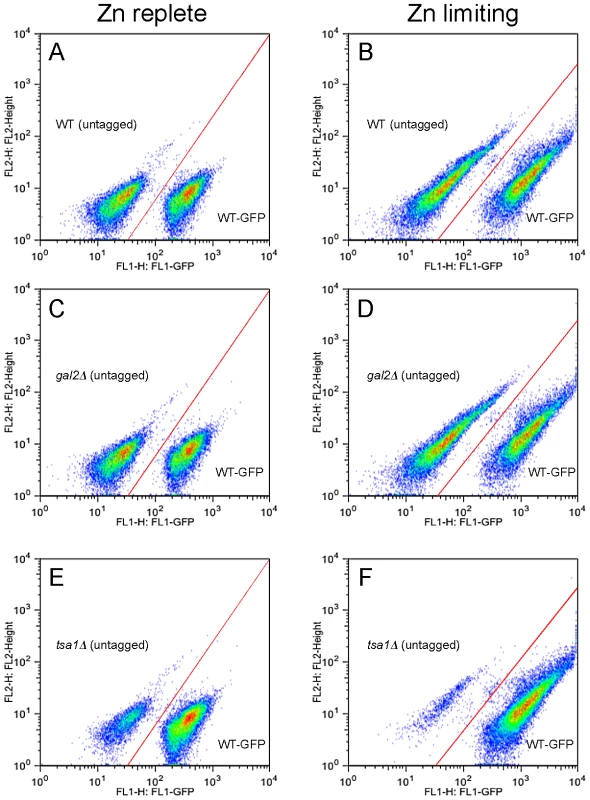
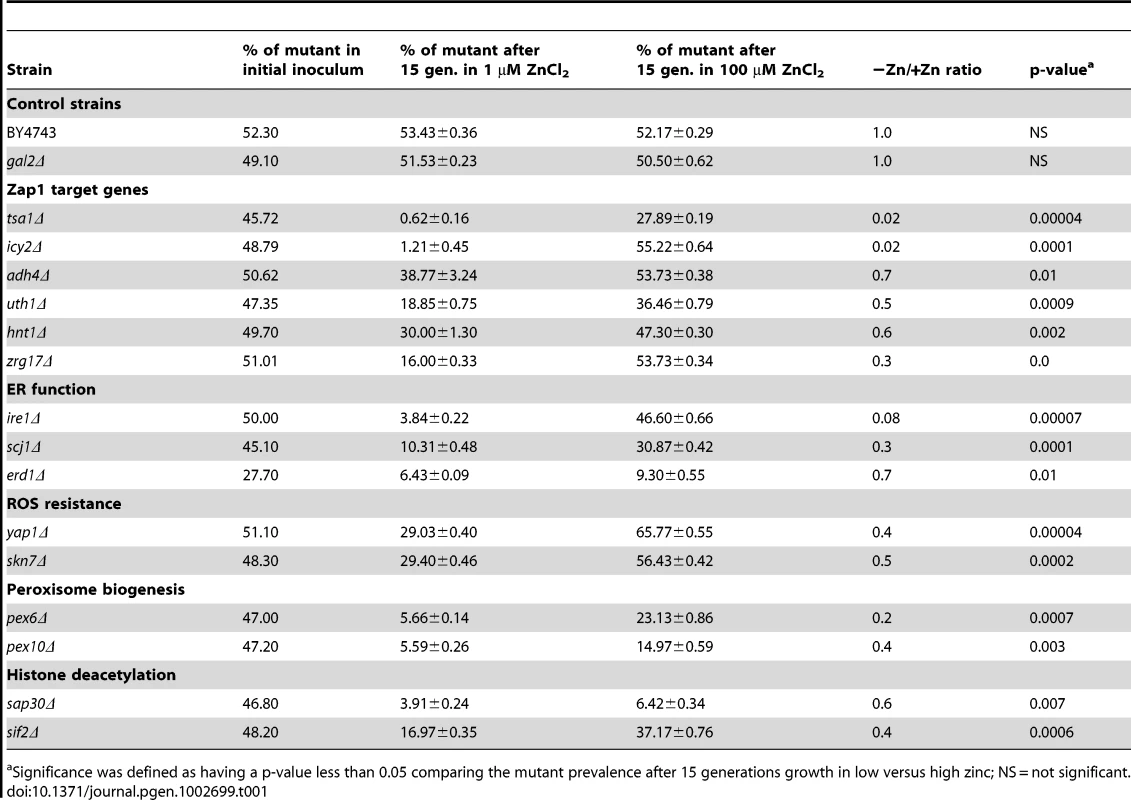
Using this method, we confirmed the results for fifteen of the mutants that showed poor low zinc growth in the functional profiling analysis (Table 1). Several of the mutants (e.g. tsa1Δ, uth1Δ, scj1Δ, erd1Δ) showed decreased competitive fitness relative to wild type in zinc-replete media but that growth defect was exacerbated by low zinc conditions. Independent confirmation of the low zinc growth defects of these strains indicated that the functional profiling results were very reliable.
Functional enrichment and network mapping implicate a limited set of cellular processes and components as required for optimal low zinc growth
We analyzed the low zinc sensitive set of 433 genes identified in the five and fifteen generation experiments (Table S1) for enrichment of biological attributes by identifying significantly overrepresented GO (Gene Ontology) and MIPS (Munich Information Center for Protein Sequences) categories (Table 2). A number of categories were found to be enriched, including autophagy (GO category GO:0006914), the endosome (GO:0005768), vacuolar/lysosomal transport (MIPS category 20.09.13), modification by acetylation/deacetylation (14.07.04) and the peroxisomal membrane (760.01).
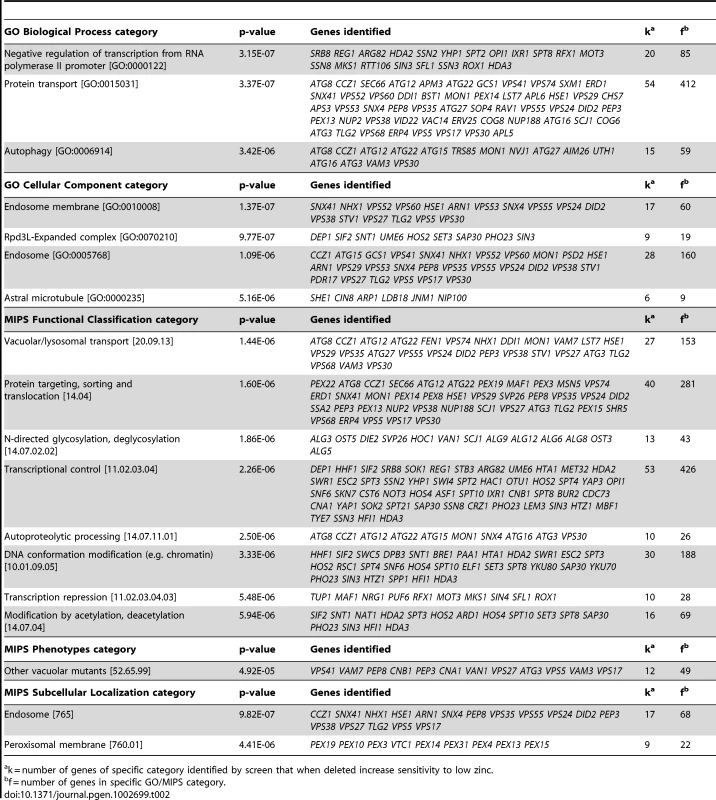
To provide further insight into the biological processes required for the tolerance of zinc limitation, we performed a network mapping analysis. Fitness data for all sensitive strains identified in this study were mapped onto the BioGRID S. cerevisiae functional interaction data set. Fitness scores for each mutant, i.e. the difference in the mean of the log2 hybridization signal between LZM+1 µM ZnCl2 and LZM+100 µM ZnCl2, were then used to identify a sub-network within the BioGRID network enriched for genes that have sensitive fitness data associated with them, and so may identify cellular processes or protein complexes affected by zinc limitation. Mutants sensitive to low zinc were then assessed for significant overrepresentation of GO categories, which can be visualized in many different ways (Figure 3). Cellular components identified included the endoplasmic reticulum, the peroxisome, the Golgi apparatus, and histone deacetylase complexes.
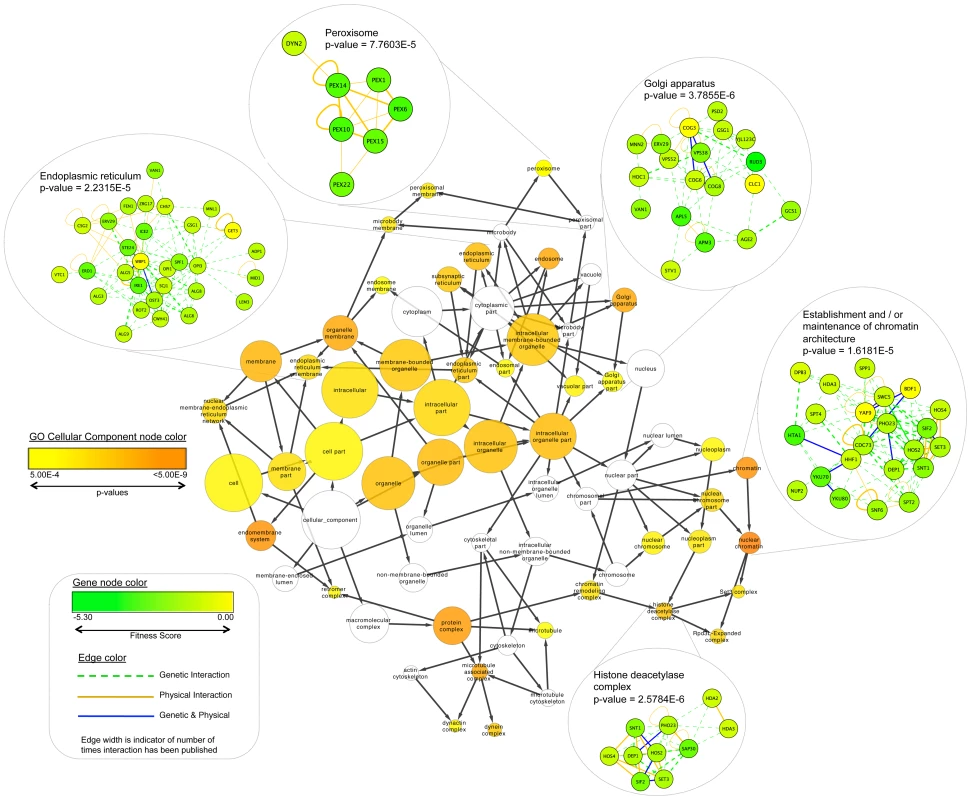
A subset of Zap1 targets are important for low zinc growth
Representative fitness scores from the microarray data for some of the mutants identified as low zinc sensitive are listed in Table 3. A fitness score less than 0 indicates a low zinc growth defect. Mutants disrupted for several Zap1-regulated genes showed poor low zinc growth consistent with their normally induced expression under these conditions. These genes were TSA1, ICY2, ADH4, UTH1, HNT1, and ZRG17.
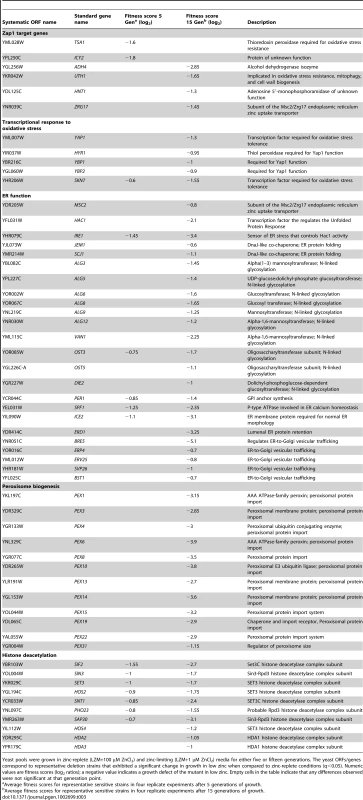
Low zinc and oxidative stress
We had also previously shown that zinc-limited yeast cells produce more reactive oxygen species than do replete cells [22]. Induction of TSA1 by Zap1 is critical for tolerating this increased ROS. Functional profiling suggests that a specific oxidative stress response mechanism is also activated in low zinc. Yap1 and Skn7 are transcription factors that activate antioxidant and heat shock genes in response to oxidative stress [27]. We found that mutants defective for these two factors are defective for low zinc growth (Table 3). In addition, three accessory factors (HYR1, YBP1, YBP2) required for full Yap1 activity were also identified as growing poorly in low zinc [27]–[29].
Zinc and organellar function
Many genes related to endoplasmic reticulum function were also identified (Table 3). These included MSC2, which encodes a zinc transporter protein that, along with Zrg17 (see above), transports zinc into the ER. HAC1 and IRE1, which encode the transcription factor and its controlling sensor that are active in the ER unfolded protein response (UPR), molecular co-chaperones (JEM1, SCJ1), and several genes involved in ER protein modification and trafficking were identified as growing poorly in low zinc. These results suggested that disruption of ER function in many different ways impairs the ability of cells to grow in low zinc. To test this hypothesis further, we examined the effects of tunicamycin, an inducer of ER stress [30], [31], on low zinc growth. Cells were grown in either low zinc (LZM+1 µM ZnCl2) or zinc-replete conditions (LZM+100 µM ZnCl2) with a range of tunicamycin concentrations. As shown in Figure 4, sensitivity to tunicamycin was greatly exacerbated by growth in low zinc medium relative to zinc-replete conditions. These results support the hypothesis that unperturbed ER function is critical to growth when zinc is scarce.
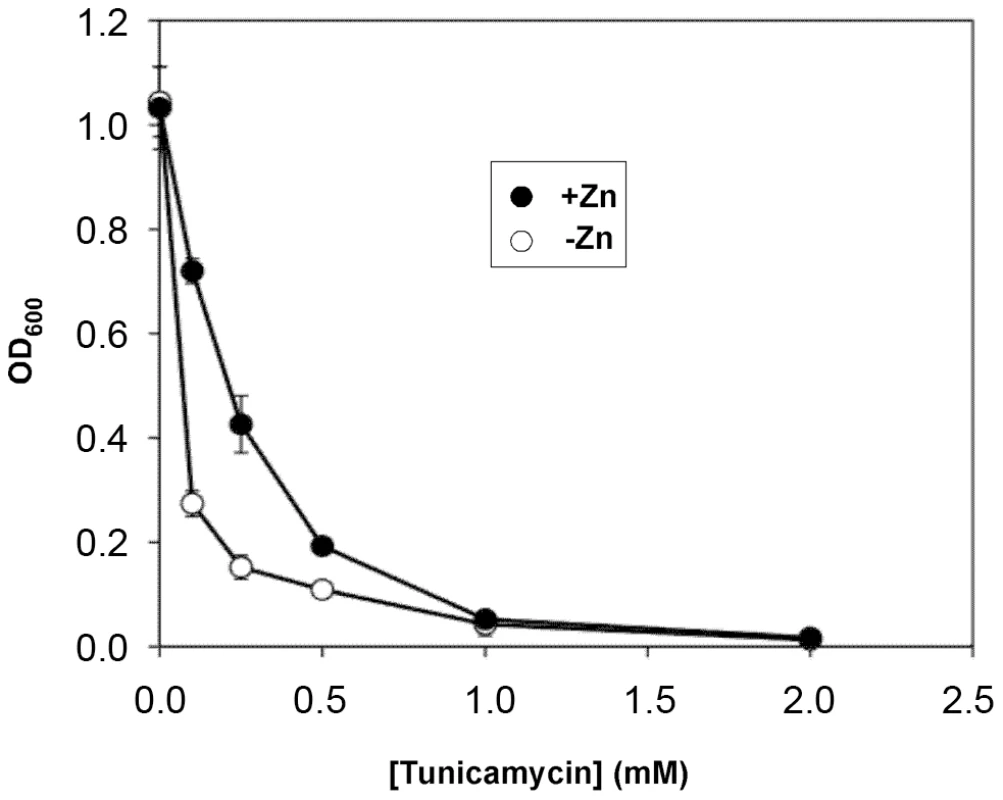
Surprisingly, thirteen mutant strains disrupted for peroxisome biogenesis genes were defective for low zinc growth (Table 3). The peroxisome is required for fatty acid β–oxidation in yeast but no fatty acids were supplied as carbon source to these cells. Thus, the importance of the peroxisome in low zinc is unknown.
Histone deacetylases
The functional enrichment of genes encoding histone deacetylase subunits (i.e. SIF2, SIN3, SET3, HOS2, SNT1, PHO23, SAP30, HOS4, HDA2, and HDA3) indicates that chromatin structure plays an important role in low zinc.
A role for macroautophagy during low zinc growth
Autophagy, the process whereby cells degrade cytosolic proteins and organelles to recycle their components [32] was identified as required for low zinc growth (i.e. “autoproteolytic processing”, Table 2). Autophagy can be subdivided into a number of separate processes including the nonspecific pathway of macroautophagy and the cargo-specific pathways of cytoplasm-to-vacuole targeting (CVT), mitochondria-specific autophagy (mitophagy), and peroxisome-specific autophagy (pexophagy). Several genes involved in both macroautophagy and the cargo-specific pathways, referred to as “core” genes, were found to have a low zinc growth defect by functional profiling; these and additional core autophagy factor mutants (i.e. atg6Δ, atg17Δ) were confirmed by flow cytometry to have a low zinc growth defect (Table 4). Mutations in cargo-specific factors had much less effect on low zinc growth. For example, ATG11 is required for both the CVT pathway and pexophagy but the atg11Δ mutant grew better in low zinc than in the zinc-replete medium. In addition, mutation of the CVT-specific factor ATG19 had little effect. Mutation of MID2 and SLT2, which are both required for pexophagy, had a modest effect on low zinc growth when assayed by flow cytometry but these genes are also required for maintenance of cell wall integrity. Thus, their low zinc growth defect may be due to disruption of roles unrelated to pexophagy. Finally, mutations specifically disrupting mitophagy (e.g. atg32Δ, atg33Δ) had little or no effect on low zinc growth. We conclude from these genetic studies that macroautophagy is required for low zinc growth but the cargo-specific pathways of CVT, pexophagy, and mitophagy are not.
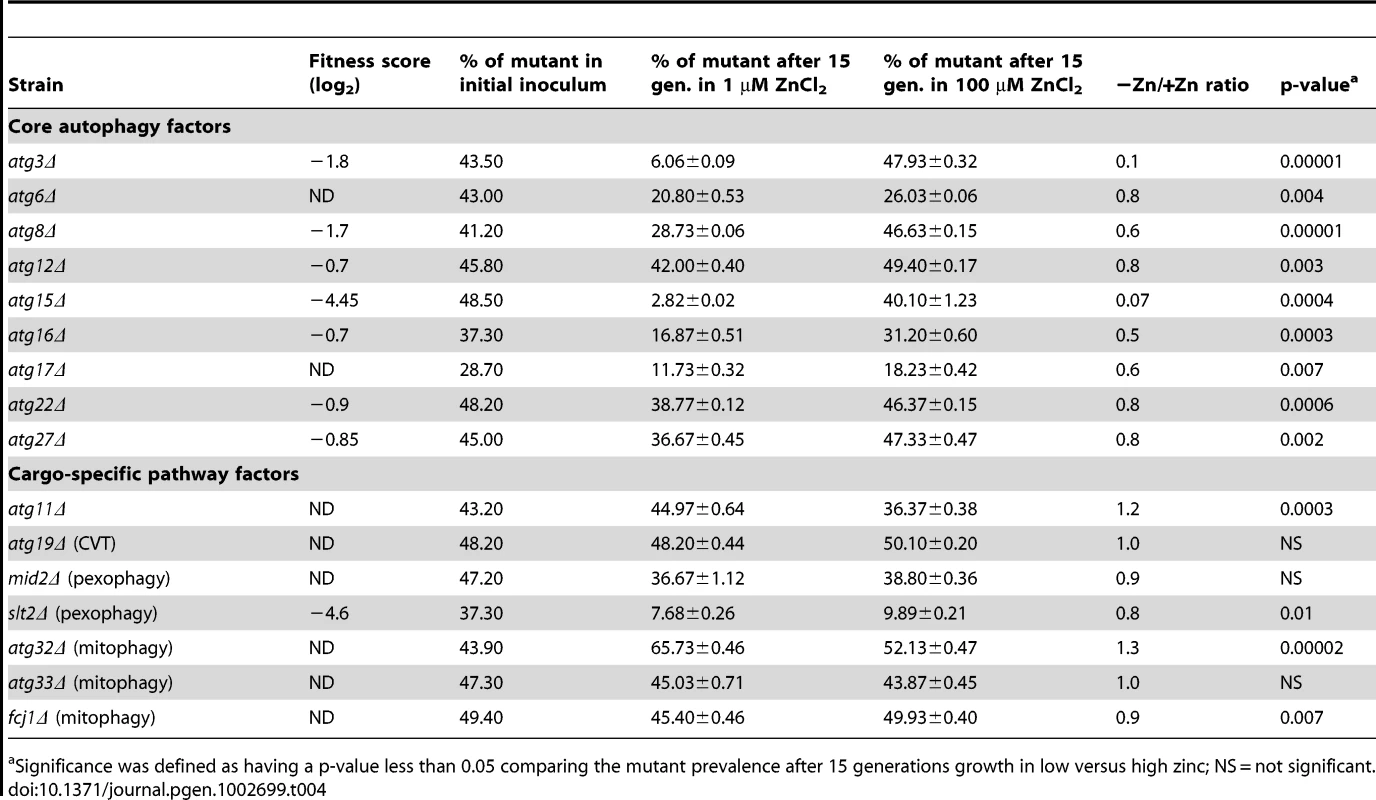
To determine whether macroautophagy is required for growth when other metal ions are limiting, we examined growth of several of the mutants defective for macroautophagy under conditions of iron or copper limitation (Table S4). Iron limitation was induced by adding the iron chelator bathophenanthroline disulfonate (BPS, 100 µM) and copper limitation was imposed by adding the copper chelator bathocuproine disulfonate (BCS, 200 µM) to YPD medium. The four autophagy mutants tested (atg3Δ, atg8Δ, atg15Δ, and atg16Δ) showed little or no growth defect in low iron or low copper. In fact, these four mutants showed improved growth in low iron. As a positive control for a low iron growth defect, a fet3Δ mutant grew poorly on BPS but not on BCS. FET3 encodes a component of the high affinity iron uptake system. As a positive control for a defect in low copper, an irc21Δ mutant was used and found to grow poorly on BCS but not BPS. IRC21 encodes a putative cytochrome oxidoreductase and the low copper growth defect of the irc21Δ was observed in our previous studies (W. Jo, C. Vulpe, unpublished). When tested in minimal media, the greater importance of autophagy to low zinc growth relative to iron- or copper-limiting conditions was confirmed (Table S5).
The ICE2 gene is required for ER zinc homeostasis
As another illustration of the power of functional profiling to identify novel genes important for low zinc growth, we focused our attention on the ICE2 gene. ICE2 was previously identified as being needed for proper ER morphology [33]. Ice2 is an integral membrane protein with eight potential transmembrane domains suggesting that it is a transporter of some type. Our previous results indicated that the Msc2/Zrg17 zinc transporter complex plays the major role in maintaining ER zinc while the vacuolar Zrc1 and Cot1 zinc transporters also contribute [23], [34]. Our results had also indicated that additional ER zinc transporters were present and we therefore hypothesized that the substrate for Ice2-mediated transport was zinc. Consistent with that hypothesis, ice2Δ mutants grew poorly in low zinc (Table 3). We confirmed this growth defect by inoculating wild type and ice2Δ mutant cells into batch cultures and measuring culture density after overnight growth (Figure 5A). The ice2Δ mutants grew poorly relative to wild-type cells in LZM+1 µM Zn but adding as little as 3 µM Zn to the medium was sufficient to restore near wild-type growth. Higher concentrations were similarly effective (data not shown). This result indicated that Ice2 is required for optimal growth under severe zinc-limiting conditions but not under more moderate conditions. Zinc-deficient wild-type cells have induced expression of the ER-stress induced unfolded protein response (UPR) and this induction is exacerbated in mutants disrupted for MSC2 or ZRG17 [23], [34]. Zinc supplements suppress UPR induction of both wild type and mutant cells indicating that luminal ER zinc is required for function of this compartment. Consistent with ice2Δ disrupting ER zinc homeostasis, we found that a UPRE-lacZ reporter was also hyper-induced in a zinc-limited ice2Δ mutant relative to wild-type cells and this hyper-induction was suppressed by supplementing zinc at 10 µM or above (Figure 5B, data not shown). We also deleted the ICE2 gene in a strain in which all four genes known to contribute to ER zinc were mutated (i.e. msc2Δ zrg17Δ zrc1Δ cot1Δ). Loss of Ice2 function in this quadruple mutant background caused still greater induction of the UPR when zinc was supplied at a concentration of 3 µM but the UPR was still suppressible with higher concentrations of zinc (Figure 5C).
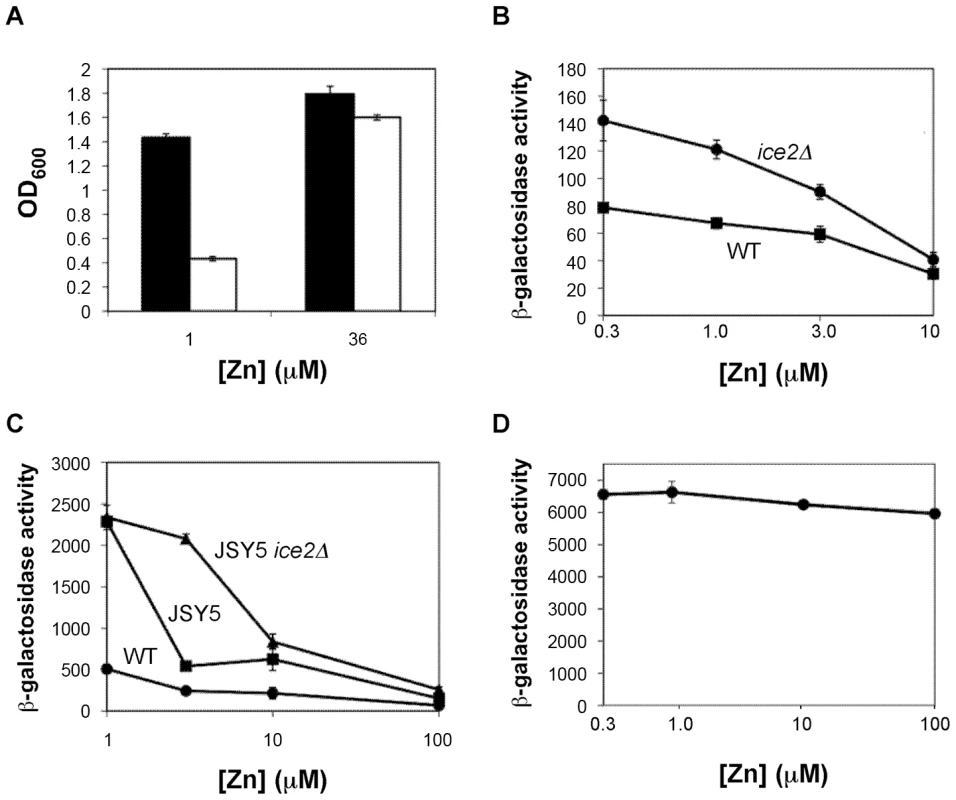
In control experiments, we confirmed that zinc supplements do not inhibit UPR induction in response to other ER stressors such as tunicamycin (Figure 5D). Therefore, these results suggest that Ice2 either directly or indirectly influences zinc homeostasis in the ER. To assess whether Ice2 could itself be a zinc transporter contributing to ER zinc levels, we tested if overexpression of Ice2 could suppress phenotypes caused by inactivation of ER zinc transport. Contrary to this hypothesis, Ice2 overexpression from the GAL1 promoter failed to suppress the poor growth of msc2Δ mutants on respired carbon sources at elevated temperatures and also did not suppress UPR hyper-induction in an msc2Δ single mutant nor an msc2Δ zrg17Δ zrc1Δ cot1Δ quadruple mutant (data not shown). Thus it does not appear that Ice2 transports zinc directly but may transport another substrate that is required for optimal ER zinc trafficking.
Analysis of mutants with apparent “resistance” to growth in low zinc
Over 500 mutant strains were identified by functional profiling as having an apparent fitness advantage in low zinc (Figure 1B). Many of these genes were found to encode subunits of the cytosolic and mitochondrial ribosomes (Table S6, Figure S1A, S1B). We tested these results independently by flow cytometry and found that the apparent zinc resistance of many of these strains is likely due to growth defects caused by these mutations under all conditions (Table 5). For example, rsm27Δ, rpl2bΔ, rps7aΔ, and rpl6bΔ mutants grown in zinc-replete conditions grew very poorly relative to wild-type cells. These mutants also grew less well than wild type in zinc-limiting conditions but were better able to compete when the wild-type strain is growth limited. Thus, a likely explanation for the functional profiling results is that in low zinc, growth of the wild-type strain is slowed by zinc deficiency to a rate closer to that of the mutant. In zinc-replete media, the wild-type strain grows at a much faster rate while the mutant growth is still impeded by the mutation and competes less well with wild type. Direct analysis of rpl2bΔ growth supported this hypothesis (Figure S1C). This effect could also explain the apparent low zinc resistance of fet3Δ, ftr1Δ, and fre1Δ mutants (Table S2); these genes are required for high affinity iron uptake and their respective mutants grow poorly in EDTA-containing LZM media regardless of zinc supplements.
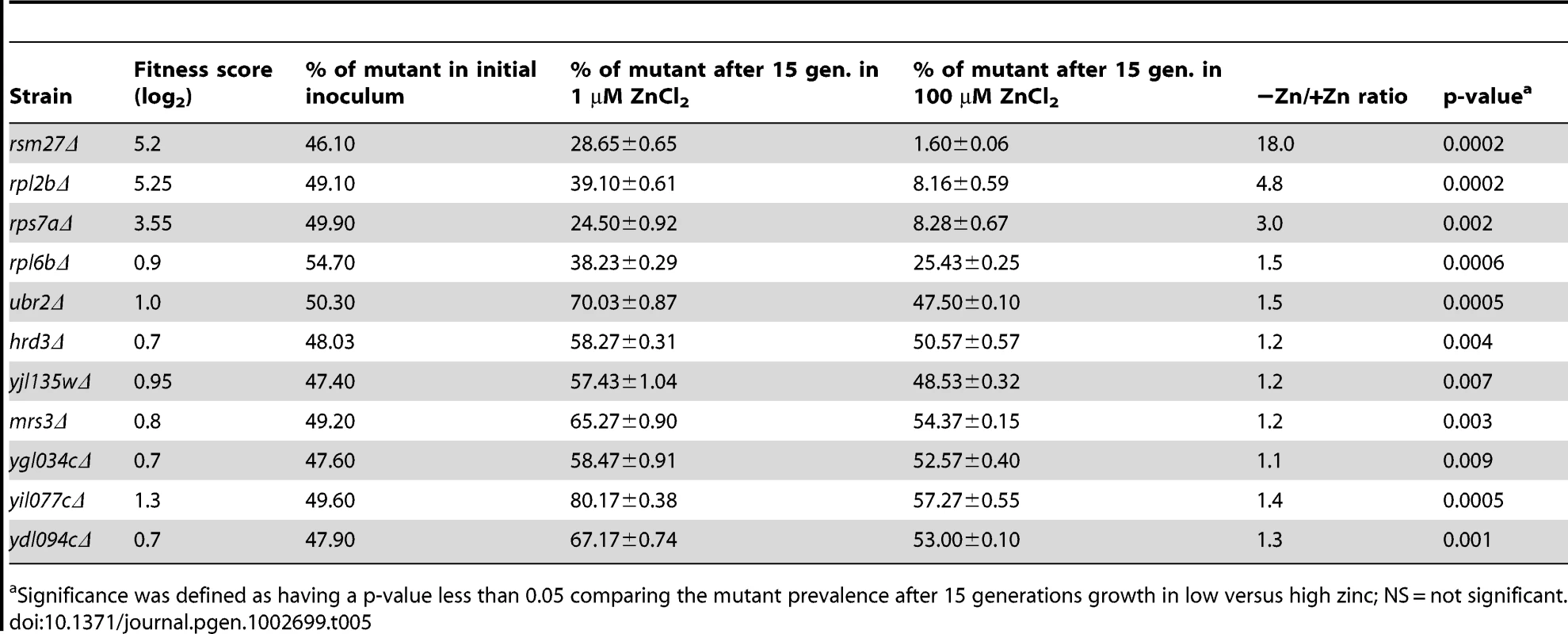
Of the 513 total strains showing apparent low zinc resistance (Table S2), 359 are documented to have a fitness disadvantage relative to wild-type cells in zinc-replete media (Saccharomyces Genome Database, http://www.yeastgenome.org/). Therefore, these mutants are likely to show apparent low zinc resistance by the same mechanism as was found for the ribosomal subunit mutants. We assayed growth of the remaining mutants with no known fitness defect and found that seven of these did indeed confer a growth advantage relative to wild-type cells in low zinc (Table 5). These include the UBR2 and HRD3 genes that encode protein-ubiquitin ligases involved in the degradation of aberrant cytosolic and ER proteins respectively [35], [36]. MRS3 encodes a mitochondrial iron transporter [37]. Why mutation of these genes improves low zinc growth remains to be determined.
Discussion
The goal of this study was to identify cellular processes in yeast that contribute to growth under zinc-limiting conditions. We found 433 different genes that are required for optimal growth in low zinc consistent with the many diverse processes in which zinc is involved. Zinc limitation might perturb cellular function by reducing the amount of cofactor available to enzymes, transcription factors, and other proteins that require the metal. Functional synergy between zinc limitation and mutations in genes important for these processes to occur optimally could exacerbate growth limitation.
Functional profiling versus transcriptome analyses
Previous transcriptome analysis identified many genes induced in low zinc including ∼80 that are likely direct targets of the Zap1 transcription factor. We predicted that Zap1-regulated genes would be important for zinc-limited growth and several such mutants (tsa1Δ, icy2Δ, adh4Δ, etc) were found to have growth defects in low zinc. Surprisingly, ∼90% of Zap1 target genes (72/80) were not found to have growth defects in low zinc. These mutants may have a defect too subtle to be detected even after fifteen generations but could have a fitness disadvantage relevant to natural selection. Alternatively, these genes may be important under conditions where low zinc is combined with some other stress such as high temperature [38]. Another explanation is provided by our studies of ZRC1. Zrc1 is a vacuolar zinc transporter that moves zinc into the vacuole for storage and detoxification. Surprisingly, ZRC1 is a Zap1 target gene and its expression is induced in low zinc [13]. We showed previously that this induction is not required for growth in low zinc but is needed for zinc-limited cells to survive re-supply with zinc, a condition we refer to as “zinc shock” [39]. The additional Zrc1 activity is needed to rapidly sequester the large amount of zinc that is taken up by the cell. It is possible that other Zap1 target genes are also needed to resist the toxicity of zinc shock.
With culture conditions similar to those used here, we previously identified over 400 genes that showed increased expression in zinc-limited cells [14]. Our hypothesis was that many of the genes with altered expression would be important for low zinc growth and detected in this functional profiling analysis as low zinc sensitive. Surprisingly, however, only 15 (∼4%) of the 433 genes we identified here as required for optimal low zinc growth were found previously to be up-regulated under those conditions (Table S7). This result is similar to what was previously observed for high pH, NaCl, sorbitol, or galactose treatment where only 0.3–7% of genes with increased expression under treatment conditions showed a detectable growth defect [25]. A similar lack of correlation between genes induced by DNA damaging agents and those genes needed to protect the cell against those agents has also been observed [40]. These remarkable findings indicate that, for many conditions, transcriptomic studies are a poor predictor of what genes are actually needed under adverse growth conditions. Nonetheless, the combination of transcriptomics and functional profiling studies allows us to focus on those changes in gene expression that are most critical to low zinc growth.
The role of Zap1 target genes in low zinc
Almost half of the 15 genes with both altered expression and a detectable low zinc growth defect are Zap1 target genes. Among these are ZAP1 itself and ZRT1, which encodes a high affinity zinc uptake transporter. These genes were not identified in this analysis because their mutants grow poorly in both LZM +1 and 100 µM ZnCl2 [19], [41]. Six other Zap1 targets were identified here and they are ZRG17, TSA1, UTH1, ADH4, HNT1, and ICY2. ZRG17 encodes a critical subunit of the Msc2/Zrg17 transporter complex that passes zinc into the ER [34]. We showed previously that ER function is compromised in low zinc and this effect is exacerbated by loss of Msc2/Zrg17 function. TSA1 is the major peroxiredoxin involved in oxidative stress resistance. Zinc-limited cells have elevated oxidative stress and Tsa1 is required to combat that stress [22]. UTH1 has also been implicated in oxidative stress resistance [42] and may be important in low zinc for that reason. UTH1 has also been implicated in maintaining cell wall integrity as well as in mitophagy [43], [44]. Uth1's role in mitophagy does not appear to explain the growth defect of the uth1Δ mutant because other mutants disrupted specifically for mitophagy (e.g. atg32Δ, atg33Δ) grew normally in low zinc. ADH4 encodes an alcohol dehydrogenase isozyme that is up-regulated in zinc-limited cells at the same time that expression of two other isozymes, Adh1 and Adh3, are repressed by Zap1 [45]. This has been proposed to be a mechanism of zinc conservation because Adh1 and Adh3 bind two zinc atoms per monomer while Adh4 binds only one metal ion. Poor growth of the adh4Δ mutant may reflect the decreased overall ADH activity due to Zap1-mediated repression of ADH1 and ADH3. HNT1 encodes an adenosine phosphoramidase and may serve as a possible positive regulator of Kin28 [46]. Kin28 is a subunit of TFIIH and phosphorylates the carboxy-terminal domain of RNA polymerase II to maintain transcription elongation [47]. Thus, up-regulation of HNT1 by Zap1 may enhance or help maintain transcription of genes in zinc-limited cells. Finally, ICY2 is a gene of unknown function but its importance specifically to low zinc growth is clear from our results. icy2Δ mutant cells grew as well or even better than wild type cells in zinc-replete media, but were severely defective for growth in low zinc. This growth defect appears specific for zinc; icy2Δ mutants showed no growth defect in low iron or low copper media (data not shown).
The importance of autophagy
In addition to identifying key Zap1 target genes, functional profiling highlighted a large number of other processes that are also important for low zinc growth. Of particular interest was the discovery of the need for autophagy in zinc-limited cells. Autophagy is a process whereby cells degrade cytosolic proteins and organelles to recycle their components [32]. Two of the regulatory factors that control autophagy are the Tor and PKA kinases that respond to nutrient starvation (i.e. nitrogen and carbon deficiency) to activate autophagic processes. A role for autophagy in zinc deficiency was hypothesized previously [48]. That zinc deficiency might in fact trigger autophagy in S. cerevisiae was suggested by the studies of Carman and colleagues [49] who found that accumulation of Atg8/Aut7, a marker for autophagy, increased in zinc-limited cells. Here we present evidence that autophagy is indeed important for zinc-limited growth.
Autophagy can be subdivided into several different pathways including macroautophagy, CVT, mitophagy, and pexophagy. Richie et al. previously showed that some process of autophagy was required for zinc-limited growth of Aspergillus fumigatus [50]. Specifically, atg1 mutants, which are defective for all of these pathways of autophagy in S. cerevisiae, were defective for low zinc growth. By examining the effects of various mutants affecting different autophagy pathways, we found here that macroautophagy is required for low zinc growth of S. cerevisiae and that the cargo-specific pathways are less important.
What role does autophagy play in low zinc growth? An appealing hypothesis is that its purpose is to degrade zinc-containing proteins and organelles to release that zinc for other purposes. Alternatively, the stress of low zinc could damage proteins and organellar membranes and those damaged components may need to be turned over. ER stress induces autophagy [51] and the ER stress of zinc deficiency may signal autophagy to occur. Intriguingly, mutations in autophagy genes sensitizes S. cerevisiae to high zinc indicating the need for autophagy at both ends of the range of zinc status [52].
Transcription factors required for low zinc growth
A large number of transcriptional regulators were identified as important in low zinc including Ace2, Crz1, Dal82, Gat1, Opi1, Rox1, and Ume6. These observations suggest that target genes of these factors are somehow needed under these conditions. Two other transcription factors that were found to be required for optimal growth in low zinc are Yap1 and Skn7. Both of these factors control the transcriptional response to oxidative stress [27], [53]. The poor growth of yap1Δ and skn7Δ mutants is consistent with the increased oxidative stress found in zinc-limited cells and the importance of Yap1/Skn7-mediated transcription. Also consistent with this hypothesis, we found that hyr1Δ, ybp1Δ, and ybp2Δ mutants are also defective for low zinc growth. These mutations disrupt accessory factors required for Yap1 activity [28], [29]. Paradoxically, however, no previous genome-wide expression studies identified Yap1 or Skn7 target genes as being induced in zinc-limited cells. One explanation for this apparent conflict between the transcriptomics and functional profiling is that in at least two of the transcriptome studies, a wild-type strain was used in which activation of Yap1 is much less efficient than in the strain background used in this study [54]. Thus, in strains where Yap1 induction in response to oxidative stress is strong, this transcription factor is indeed important for low zinc growth.
Organellar function in low zinc
Our results implicate certain organelles as critical to zinc-limited growth. Surprisingly, we found that the peroxisome is particularly important. The peroxisome is best known for its role in fatty acid β–oxidation and this compartment is also a site of reactive oxygen metabolism through the action of the Cta1 catalase isozyme [55]. Mutation of CTA1 did not confer sensitivity to low zinc indicating that the importance of the peroxisome in low zinc is not in combating oxidative stress (J. Steffen, unpublished result). A role of the peroxisome in fatty acid β–oxidation in zinc-limited cells would be surprising given that the cells were supplied with abundant glucose and not given exogenous fatty acids as carbon sources. It is conceivable that zinc-limited cells may have a defect in glucose utilization and catabolize lipid stores as a source of energy. This switch occurs in response to glucose deprivation [56] but a similar switch in low zinc/glucose-adequate conditions remains to be tested. In support of this hypothesis, we observed that mutations in FAT1 encoding a peroxisomal fatty acid transporter and POT1, encoding 3-ketoacyl-CoA thiolase caused some growth defect in low zinc (Table S1). These genes are required for fatty acid β–oxidation. Alternatively, other peroxisomal functions such as the glyoxylate cycle or purine metabolism may be required.
Another organelle that is clearly critical for growth in low zinc is the endoplasmic reticulum. We showed previously that zinc deficiency induces ER stress in wild-type cells and that this stress is exacerbated by loss of the Msc2/Zrg17 transporter complex that passes zinc into the ER lumen. Consistent with these results, we observed here that mutants lacking Msc2 or Zrg17 show a low zinc growth defect. We also found that loss of either Ire1 or Hac1, the regulatory components of the ER stress response pathway, also impairs low zinc growth. This is consistent with the need to counter the increased ER stress. More unexpectedly, we found that genes involved in ER protein folding (e.g. JEM1, SCJ1), glycosylation (e.g. ALG3, ALG5, OST3, OST5), ER Ca homeostasis (SPF1), ER-to-Golgi trafficking (e.g. BRE5, ERD1, ERP4), and other ER processes were also sensitive to low zinc. One property shared by most if not all of the ER-related mutants we identified is that they cause ER stress or reduce the ability of the cells to respond to that stress [57]. Because zinc deficiency itself is a cause of ER stress, one likely hypothesis to explain the importance of so many ER-related genes is that the poor growth is the result of combined perturbation of ER function. This hypothesis was supported by our observation that zinc-limited cells are hypersensitive to tunicamycin. ER stress can generate increased oxidative stress [58]. Therefore, an alternative hypothesis is that disruption of ER function adds to the oxidative stress experienced normally by zinc-deficient cells. Disruption of ER function appears to be zinc-specific; no defect was observed for either hac1Δ or ire1Δ mutants in either low iron or low copper minimal media that were zinc replete (Table S5).
As one final example, we identified the ICE2 gene as potentially important for ER zinc homeostasis. This gene was not required for growth in either low iron or low copper (Table S5). Ice2 is a predicted integral membrane protein with eight transmembrane domains and as other transporter proteins are required for zinc transport into ER lumen, we hypothesized that Ice2 might be a zinc transporter. While our results did not support this hypothesis, they did suggest that Ice2 is required for ER zinc homeostasis in some way. This conclusion was supported by results of a genome-wide screen of synthetic growth defects that linked Ice2 function with that of Zrg17 and the ER zinc transporter complex [59]. Thus, this functional profiling analysis has identified key metabolic processes that play important roles in low zinc and has also identified possible new roles for specific genes of unknown function.
Materials and Methods
Strains and media
Diploid yeast deletion strains used for functional profiling and for analysis of individual strains were of the BY4743 background (MATa/MATα his3Δ1/his3Δ1 leu2Δ0/leu2Δ0 lys2Δ0/LYS2 MET15/met15Δ0 ura3Δ0/ura3Δ0) (Invitrogen Corporation, Carlsbad, CA). JSY5 has the genotype of MATα his3Δ leu2Δ trp1Δ ura3Δ msc2Δ::kanMX4 zrg17Δ::natMX4 zrc1Δ::HIS3 cot1Δ::URA3. Cells were grown in a rich medium (YPD, 1% yeast extract, 2% peptone, 2% glucose) or low zinc medium (LZM) prepared as previously described [60]. LZM is zinc limiting because it contains 1 mM EDTA and 20 mM citrate to buffer metal availability. Therefore, only a small fraction of the total zinc in LZM is available for uptake by cells. Zinc was supplied as ZnCl2. An iron-limiting medium was generated by adding the iron chelator bathophenanthroline disulfonate (BPS, 100 µM) and copper limitation was imposed by adding the copper chelator bathocuproine disulfonate (BCS, 200 µM) to YPD medium. Also, LZM was made iron-limiting by leaving out the iron supplement and adding 100 µM ZnCl2 to make it zinc replete. Iron was then supplemented to either 1 (low iron) or 100 (replete iron) µM FeCl3. LZM was modified to control copper availability by leaving out the copper supplement and replacing the EDTA with 200 µM BCS. Copper was then supplemented to either 0.1 (low copper) or 10 (replete copper) µM CuCl2. Preliminary growth experiments confirmed that these conditions were limiting or replete for the respective metal.
Growth curve assays
To assess the effect of limiting zinc on growth, yeast strains were pre-grown to mid-log phase in LZM+100 µM ZnCl2, diluted to an optical density at 595 nm (OD595) of 0.0165 in either LZM+1 µM ZnCl2 or LZM+100 µM ZnCl2, and dispensed in triplicate into different wells of a 48-well plate (non-treated polystyrene, Grenier Bio-One, Monroe, NC). Plates were incubated in a GENios microplate reader (Tecan, Durham, NC) set to 30°C with intermittent shaking. OD595 measurements were taken at 15-minute intervals for a period of 24 hours. Raw absorbance data were averaged for all replicates, background corrected, and plotted as a function of time. The area under the curve (AUC) as a measure of growth was calculated with Excel 2008 (Microsoft Corporation, Redmond, WA).
Cell culturing for functional profiling analysis
For the analysis of fitness over five generations, cells from frozen aliquots of the deletion collection pools were inoculated into 100 ml culture volumes in 250 ml metal-free polycarbonate Erlenmeyer flasks to a starting OD600 of 0.04 (6×105 cells per ml). The cultures were then incubated with aeration at 30°C and grown to a final OD600 of 1.2 (1.8×107 cells per ml). For the fifteen-generation experiments, the cells were inoculated at a starting OD600 of 0.005 (7.5×104 cells per ml) and grown to an OD600 of 1.2 (eight generations), reinoculated into fresh media at a starting OD600 of 0.01 (1.5×105 cells per ml) and grown to a final OD600 of 1.2 (seven generations). The initial inocula are equal to 0.75–6×107 total cells. Thus, the cultures were inoculated with ∼1,600–13,000 cells of each mutant genotype. Four independent replicate cultures were used for each condition of zinc and generation number. After the desired generation number was reached, the cells were chilled, centrifuged at 1000×g for 6 min at 4°C, and the pellets resuspended in 2 ml dH20. The resuspensions were divided equally among three microfuge tubes, centrifuged at 1000×g for 5 min, the supernatant was removed and the pellets frozen at −80°C.
Functional profiling analysis
Extraction of genomic DNA from cultured cells, PCR amplification of barcodes, and Affymetrix TAG4 array hybridization were performed as previously described [61]. An added genomic DNA purification step was conducted following DNA extraction using the Zymo Genomic DNA Clean and Concentrator kit (Zymo Research Corporation, Irvine, CA). The data discussed in this publication have been deposited in NCBI's Gene Expression Omnibus and are accessible through GEO Series accession number GSE37254 (http://www.ncbi.nlm.nih.gov/geo/query/acc.cgi?acc=GSE37254).
Differential strain sensitivity analysis (DSSA)
Raw microarray data were processed and significant strains identified as previously described [61]. Briefly, a fitness score (ave(log2{Y|X = LZM1})-ave(log2{Y|X = LZM100}), the difference in the mean of the log2 hybridization signal between LZM+1 µM ZnCl2 and LZM+100 µM ZnCl2) was calculated for each deletion strain, to identify those differentially sensitive. This fitness score is an indicator of the effect of low zinc on the growth of the deletion strain. A negative fitness score indicates the deletion strain is sensitive to zinc limitation.
Significant genes (strains) were statistically inferred using an exact binomial test, assuming that the outcomes for each gene in all effective treatment-control pairs were independent binary variables with the same probability of success (p = 0.5) for all trials (Bernoulli trials) [61]. For a particular gene n, outcomes were considered as “successful” if they were significant in the outlier analysis with q-values≤0.05 in each of all effective pairs with log2 ratios of the same sign, simultaneously. The corresponding raw p-values based on the exact binomial test were then corrected for multiplicity of comparisons using q-value approach and only the genes with q-value≤0.05 were considered for further analysis. This approach does not apply a scale estimator and, as a result, it does not require between-chip pair normalization for the statistical inference.
Functional enrichment analysis of DSSA results
Data sets from DSSA were verified for enrichment of any particular biological attribute by identifying significantly overrepresented Gene Ontology (GO) categories [62] and MIPS (Munich Information Center for Protein Sequences) categories [63] by a hypergeometric distribution using the Functional Specification resource, FunSpec (http://funspec.med.utoronto.ca/) [64], with a p-value cutoff of 0.01 and Bonferroni correction.
Cytoscape network mapping analysis
Fitness data for all significantly sensitive strains identified from this study were mapped onto the S. cerevisiae BioGRID interaction dataset [65] using the software package Cytoscape [66]. The jActiveModules Cytoscape plug-in [67] was then used to identify functional modules (sub-networks) within the BioGRID network based on fitness data that are enriched for nodes (genes) that have sensitive fitness data associated with them, and so may identify cellular processes or protein complexes affected by zinc limitation. The sub-network with the highest significance score, comprising 283 genes (including both sensitive genes and the non-sensitive and essential genes that link them through known genetic and physical interactions) was then assessed for significant overrepresentation of Gene Ontology (GO) categories using the Cytoscape plug-in BiNGO [68]. A similar approach was used for analyzing the mutants with apparent low zinc resistance.
Analysis of relative growth by flow cytometry
The BY4743 wild-type strain was transformed with an integrating vector that expresses GFP from the strong TEF2 promoter [26]. The site of insertion is the HIS3 gene that is already mutant in the parental strain. The GFP-tagged wild-type strain and untagged isogenic mutant strains were grown overnight to exponential phase (OD600 = 0.5) in YPD, mixed in approximately equal numbers, and then inoculated into LZM+1 or 100 µM ZnCl2. Cells were first inoculated into 5 ml cultures with a starting OD600 of 0.00375 and grown to an OD600 of 1.0. These cells were then inoculated into fresh cultures of the same media to an OD600 of 0.0075 and grown to a final OD600 of 1.0 for a total of fifteen generations. Approximately 20,000 total cells per culture were analyzed by flow cytometry using a FACSCalibur flow cytometer (BD Biosciences) and an air-cooled 488 nm argon ion laser. A 530/30 filter was used for measuring GFP fluorescence and a 585/42 filter was used to detect autofluorescence exhibited by both tagged and untagged cells. GFP-expressing wild type cells were readily distinguished from untagged mutant cells. In control experiments, wild-type cells that had lost GFP expression were found to be rare (i.e. <1% of the total cells) and therefore contribute little variability to mutant cell counts. Means of three independent cultures are reported with standard deviations and statistically significant differences between the low zinc and zinc-replete cultures were determined using Student's t-test.
Supporting Information
Zdroje
1. AndreiniCBanciLBertiniIRosatoA 2006 Counting the zinc-proteins encoded in the human genome. J Proteome Res 5 196 201
2. HiranoTMurakamiMFukadaTNishidaKYamasakiS 2008 Roles of zinc and zinc signaling in immunity: zinc as an intracellular signaling molecule. Adv Immunol 97 149 176
3. MurakamiMHiranoT 2008 Intracellular zinc homeostasis and zinc signaling. Cancer Sci 99 1515 1522
4. RhodesDKlugA 1993 Zinc fingers. Sci Am 268 56 65
5. Kehl-FieTESkaarEP 2010 Nutritional immunity beyond iron: a role for manganese and zinc. Curr Opin Chem Biol 14 218 224
6. LiuzziJPLichtenLARiveraSBlanchardRKAydemirTB 2005 Interleukin-6 regulates the zinc transporter Zip14 in liver and contributes to the hypozincemia of the acute-phase response. Proc Natl Acad Sci U S A 102 6843 6848
7. HsuKChampaiboonCGuentherBDSorensonBSKhammanivongA 2009 Anti-Infective Protective Properties of S100 Calgranulins. Antiinflamm Antiallergy Agents Med Chem 8 290 305
8. SohnlePGHahnBLSanthanagopalanV 1996 Inhibition of Candida albicans growth by calprotectin in the absence of direct contact with the organisms. J Infect Dis 174 1369 1372
9. SohnlePGHunterMJHahnBChazinWJ 2000 Zinc-reversible antimicrobial activity of recombinant calprotectin (migration inhibitory factor-related proteins 8 and 14). J Infect Dis 182 1272 1275
10. LoomansHJHahnBLLiQQPhadnisSHSohnlePG 1998 Histidine-based zinc-binding sequences and the antimicrobial activity of calprotectin. J Infect Dis 177 812 814
11. LulloffSJHahnBLSohnlePG 2004 Fungal susceptibility to zinc deprivation. J Lab Clin Med 144 208 214
12. CorbinBDSeeleyEHRaabAFeldmannJMillerMR 2008 Metal chelation and inhibition of bacterial growth in tissue abscesses. Science 319 962 965
13. LyonsTJGaschAPGaitherLABotsteinDBrownPO 2000 Genome-wide characterization of the Zap1p zinc-responsive regulon in yeast. Proc Natl Acad Sci U S A 97 7957 7962
14. WuCYBirdAJChungLMNewtonMAWingeDR 2008 Differential control of Zap1-regulated genes in response to zinc deficiency in Saccharomyces cerevisiae. BMC Genomics 9 370
15. GauciVJBeckhouseAGLyonsVBehEJRogersPJ 2009 Zinc starvation induces a stress response in Saccharomyces cerevisiae that is mediated by the Msn2p and Msn4p transcriptional activators. FEMS Yeast Res 9 1187 1195
16. De NicolaRHazelwoodLADe HulsterEAWalshMCKnijnenburgTA 2007 Physiological and transcriptional responses of Saccharomyces cerevisiae to zinc limitation in chemostat cultures. Appl Environ Microbiol 73 7680 7692
17. EideDJ 2009 Homeostatic and Adaptive Responses to Zinc Deficiency in Saccharomyces cerevisiae. J Biol Chem 284 18565 18569
18. ZhaoHEideD 1996 The ZRT2 gene encodes the low affinity zinc transporter in Saccharomyces cerevisiae. J Biol Chem 271 23203 23210
19. ZhaoHEideD 1996 The yeast ZRT1 gene encodes the zinc transporter protein of a high-affinity uptake system induced by zinc limitation. Proc Natl Acad Sci U S A 93 2454 2458
20. WatersBMEideDJ 2002 Combinatorial control of yeast FET4 gene expression by iron, zinc, and oxygen. J Biol Chem 277 33749 33757
21. MacDiarmidCWGaitherLAEideD 2000 Zinc transporters that regulate vacuolar zinc storage in Saccharomyces cerevisiae. EMBO J 19 2845 2855
22. WuCYBirdAJWingeDREideDJ 2007 Regulation of the yeast TSA1 peroxiredoxin by ZAP1 is an adaptive response to the oxidative stress of zinc deficiency. J Biol Chem 282 2184 2195
23. EllisCDWangFMacDiarmidCWClarkSLyonsT 2004 Zinc and the Msc2 zinc transporter protein are required for endoplasmic reticulum function. J Cell Biol 166 325 335
24. WinzelerEAShoemakerDDAstromoffALiangHAndersonK 1999 Functional characterization of the S. cerevisiae genome by gene deletion and parallel analysis. Science 285 901 906
25. GiaeverGChuAMNiLConnellyCRilesL 2002 Functional profiling of the Saccharomyces cerevisiae genome. Nature 418 387 391
26. BreslowDKCameronDMCollinsSRSchuldinerMStewart-OrnsteinJ 2008 A comprehensive strategy enabling high-resolution functional analysis of the yeast genome. Nat Methods 5 711 718
27. HerreroERosJBelliGCabiscolE 2008 Redox control and oxidative stress in yeast cells. Biochim Biophys Acta 1780 1217 1235
28. DelaunayAPfliegerDBarraultMBVinhJToledanoMB 2002 A thiol peroxidase is an H2O2 receptor and redox-transducer in gene activation. Cell 111 471 481
29. GulshanKRovinskySAMoye-RowleyWS 2004 YBP1 and its homologue YBP2/YBH1 influence oxidative-stress tolerance by nonidentical mechanisms in Saccharomyces cerevisiae. Eukaryot Cell 3 318 330
30. KuoSCLampenJO 1974 Tunicamycin–an inhibitor of yeast glycoprotein synthesis. Biochem Biophys Res Commun 58 287 295
31. JamsaESimonenMMakarowM 1994 Selective retention of secretory proteins in the yeast endoplasmic reticulum by treatment of cells with a reducing agent. Yeast 10 355 370
32. YangZKlionskyDJ 2009 An overview of the molecular mechanism of autophagy. Curr Top Microbiol Immunol 335 1 32
33. Estrada de MartinPDuYNovickPFerro-NovickS 2005 Ice2p is important for the distribution and structure of the cortical ER network in Saccharomyces cerevisiae. J Cell Sci 118 65 77
34. EllisCDMacdiarmidCWEideDJ 2005 Heteromeric protein complexes mediate zinc transport into the secretory pathway of eukaryotic cells. J Biol Chem 280 28811 28818
35. NillegodaNBTheodorakiMAMandalAKMayoKJRenHY 2010 Ubr1 and Ubr2 function in a quality control pathway for degradation of unfolded cytosolic proteins. Mol Biol Cell 21 2102 2116
36. GardnerRGShearerAGHamptonRY 2001 In vivo action of the HRD ubiquitin ligase complex: mechanisms of endoplasmic reticulum quality control and sterol regulation. Mol Cell Biol 21 4276 4291
37. MuhlenhoffUStadlerJARichhardtNSeubertAEickhorstT 2003 A specific role of the yeast mitochondrial carriers MRS3/4p in mitochondrial iron acquisition under iron-limiting conditions. J Biol Chem 278 40612 40620
38. BerryDBGaschAP 2008 Stress-activated genomic expression changes serve a preparative role for impending stress in yeast. Mol Biol Cell 19 4580 4587
39. MacDiarmidCWMilanickMAEideDJ 2003 Induction of the ZRC1 metal tolerance gene in zinc-limited yeast confers resistance to zinc shock. J Biol Chem 278 15065 15072
40. BirrellGWBrownJAWuHIGiaeverGChuAM 2002 Transcriptional response of Saccharomyces cerevisiae to DNA-damaging agents does not identify the genes that protect against these agents. Proc Natl Acad Sci U S A 99 8778 8783
41. ZhaoHEideDJ 1997 Zap1p, a metalloregulatory protein involved in zinc-responsive transcriptional regulation in Saccharomyces cerevisiae. Mol Cell Biol 17 5044 5052
42. BandaraPDFlattery-O'BrienJAGrantCMDawesIW 1998 Involvement of the Saccharomyces cerevisiae UTH1 gene in the oxidative-stress response. Curr Genet 34 259 268
43. KissovaIDeffieuMManonSCamougrandN 2004 Uth1p is involved in the autophagic degradation of mitochondria. J Biol Chem 279 39068 39074
44. RitchJJDavidsonSMSheehanJJAustriacoN 2010 The Saccharomyces SUN gene, UTH1, is involved in cell wall biogenesis. FEMS Yeast Res 10 168 176
45. BirdAJGordonMEideDJWingeDR 2006 Repression of ADH1 and ADH3 during zinc deficiency by Zap1-induced intergenic RNA transcripts. Embo J 25 5726 5734
46. BieganowskiPGarrisonPNHodawadekarSCFayeGBarnesLD 2002 Adenosine monophosphoramidase activity of Hint and Hnt1 supports function of Kin28, Ccl1, and Tfb3. J Biol Chem 277 10852 10860
47. KimHEricksonBLuoWSewardDGraberJH 2010 Gene-specific RNA polymerase II phosphorylation and the CTD code. Nat Struct Mol Biol 17 1279 1286
48. FrakerPJ 2005 Roles for cell death in zinc deficiency. J Nutr 135 359 362
49. IwanyshynWMHanGSCarmanGM 2004 Regulation of phospholipid synthesis in Saccharomyces cerevisiae by zinc. J Biol Chem 279 21976 21983
50. RichieDLFullerKKFortwendelJMileyMDMcCarthyJW 2007 Unexpected link between metal ion deficiency and autophagy in Aspergillus fumigatus. Eukaryot Cell 6 2437 2447
51. YorimitsuTNairUYangZKlionskyDJ 2006 Endoplasmic reticulum stress triggers autophagy. J Biol Chem 281 30299 30304
52. DziedzicSACaplanAB 2011 Identification of autophagy genes participating in zinc-induced necrotic cell death in Saccharomyces cerevisiae. Autophagy 7 490 500
53. LeeJGodonCLagnielGSpectorDGarinJ 1999 Yap1 and Skn7 control two specialized oxidative stress response regulons in yeast. J Biol Chem 274 16040 16046
54. OkazakiSNaganumaAKugeS 2005 Peroxiredoxin-mediated redox regulation of the nuclear localization of Yap1, a transcription factor in budding yeast. Antioxid Redox Signal 7 327 334
55. PetrovaVYDrescherDKujumdzievaAVSchmittMJ 2004 Dual targeting of yeast catalase A to peroxisomes and mitochondria. Biochem J 380 393 400
56. StanwayCAGibbsJMBerardiE 1995 Expression of the FOX1 gene of Saccharomyces cerevisiae is regulated by carbon source, but not by the known glucose repression genes. Curr Genet 27 404 408
57. JonikasMCCollinsSRDenicVOhEQuanEM 2009 Comprehensive characterization of genes required for protein folding in the endoplasmic reticulum. Science 323 1693 1697
58. TuBPWeissmanJS 2004 Oxidative protein folding in eukaryotes: mechanisms and consequences. J Cell Biol 164 341 346
59. CostanzoMBaryshnikovaABellayJKimYSpearED 2010 The genetic landscape of a cell. Science 327 425 431
60. GitanRSLuoHRodgersJBroderiusMEideD 1998 Zinc-induced inactivation of the yeast ZRT1 zinc transporter occurs through endocytosis and vacuolar degradation. J Biol Chem 273 28617 28624
61. JoWJLoguinovAWintzHChangMSmithAH 2009 Comparative functional genomic analysis identifies distinct and overlapping sets of genes required for resistance to monomethylarsonous acid (MMAIII) and arsenite (AsIII) in yeast. Toxicol Sci 111 424 436
62. AshburnerMBallCABlakeJABotsteinDButlerH 2000 Gene ontology: tool for the unification of biology. The Gene Ontology Consortium. Nat Genet 25 25 29
63. MewesHWFrishmanDGuldenerUMannhauptGMayerK 2002 MIPS: a database for genomes and protein sequences. Nucleic Acids Res 30 31 34
64. RobinsonMDGrigullJMohammadNHughesTR 2002 FunSpec: a web-based cluster interpreter for yeast. BMC Bioinformatics 3 35
65. StarkCBreitkreutzBJRegulyTBoucherLBreitkreutzA 2006 BioGRID: a general repository for interaction datasets. Nucleic Acids Res 34 D535 539
66. ShannonPMarkielAOzierOBaligaNSWangJT 2003 Cytoscape: a software environment for integrated models of biomolecular interaction networks. Genome Res 13 2498 2504
67. IdekerTOzierOSchwikowskiBSiegelAF 2002 Discovering regulatory and signalling circuits in molecular interaction networks. Bioinformatics 18 Suppl 1 S233 240
68. MaereSHeymansKKuiperM 2005 BiNGO: a Cytoscape plugin to assess overrepresentation of gene ontology categories in biological networks. Bioinformatics 21 3448 3449
Štítky
Genetika Reprodukční medicínaČlánek vyšel v časopise
PLOS Genetics
2012 Číslo 6
- Primární hyperoxalurie – aktuální možnosti diagnostiky a léčby
- Mateřský haplotyp KIR ovlivňuje porodnost živých dětí po transferu dvou embryí v rámci fertilizace in vitro u pacientek s opakujícími se samovolnými potraty nebo poruchami implantace
- Intrauterinní inseminace a její úspěšnost
- Akutní intermitentní porfyrie
- Srdeční frekvence embrya může být faktorem užitečným v předpovídání výsledku IVF
Nejčtenější v tomto čísle
- Rumors of Its Disassembly Have Been Greatly Exaggerated: The Secret Life of the Synaptonemal Complex at the Centromeres
- The NSL Complex Regulates Housekeeping Genes in
- Tipping the Balance in the Powerhouse of the Cell to “Protect” Colorectal Cancer
- Interplay between Synaptonemal Complex, Homologous Recombination, and Centromeres during Mammalian Meiosis
